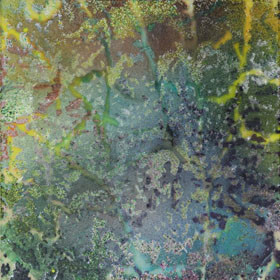José María Sicilia
24 Mar - 05 May 2007

© José Maria Sicilia
Eclipses
2006
Oil painting on bees wax
103 x 103 cm
Courtesy of the artist & Galerie Chantal Crousel
Photo Florian Kleinefenn
Eclipses
2006
Oil painting on bees wax
103 x 103 cm
Courtesy of the artist & Galerie Chantal Crousel
Photo Florian Kleinefenn
JOSÉ MARÍA SICILIA
"Eclipses"
The Chantal Crousel Gallery is proud to announce José María Sicilia’s new exhibition. “Eclipses” is the title given to a cycle of paintings (oil painting on beeswax) and drawings (gouaches, graphite on Japanese paper) that explores the butterfly phenomenon as an image of fugaciousness.
"We could almost risk the hypothesis that a different aspect of the butterfly’s life corresponds to each fundamental dimension of the image: their beauty and the infinite variety of their shapes and colours; the temptation and the impossibility of a thorough knowledge about those frail and ever multiplying things that are both images and butterflies; the paradox of the form and the formless implied by the metamorphosis."1
Sicilia's work subtly brings together a poetic approach and a reflexion on the form. He undertakes a "search for the heart of the painting"2, a search that involves an observation of how the light and the material interact in each piece. After “La Luz que se Apaga”, the “Eclipses” series is an expression of that stealthy light, still central in José María Sicilia's pursuit, which echoes his attempt to approach the intangible mystery of death.
The artist’s travelling, especially in Arabo-Muslim countries and more generally in the oriental world are what provide for his inspiration. His interest for that culture is conveyed in his work by the use of patterns and material that have a spiritual consistency. José María Sicilia strongly believes in the continuity of intercultural exchange as tomorrow’s mean of communication. “For Sicilia beeswax became an indispensable material in his pictorial dialogue with light; the degree of intensity possessed by this luminous substance, not only in the memory of its spilling in liquid form on the surface of the painting, but in the way it receives the paint and reflects the light to create an empty space in its interior.”2
In her text "Las Mil Noches y una Noche", Alicia Chillida explains: “Sicilia winters in Paris, and his drawings were made in the season of cold; however, the large, luminous paintings in wax emerged in the spring and autumn. It appears that the rhythms of his production were in accord with the cycles of nature, the harvest, migrations of bird, the microscopic world of insects. It is as if there had been a profound interchange between the macrocosm and the microcosm, between dreaming and wakefulness.”2
At this occasion, a book “Eclipses” is published by the Chantal Crousel Gallery with a text by Georges Didi-Huberman.
-----------
1: Georges Didi-Huberman, "L'image papillon", in "José Maria Sicilia, Eclipses", ASSN publishing, Chantal Crousel Gallery, 2007.
2 : Extracts from “Las Mil Noches y una Noche” by Alicia Chillida in “Las Mil y Una Noches”, by José María Sicilia, Enrique Morente and Juan Goytisolo, Centro Atlántico de Arte Moderno publications (CAAM), 2005-2006
"Eclipses"
The Chantal Crousel Gallery is proud to announce José María Sicilia’s new exhibition. “Eclipses” is the title given to a cycle of paintings (oil painting on beeswax) and drawings (gouaches, graphite on Japanese paper) that explores the butterfly phenomenon as an image of fugaciousness.
"We could almost risk the hypothesis that a different aspect of the butterfly’s life corresponds to each fundamental dimension of the image: their beauty and the infinite variety of their shapes and colours; the temptation and the impossibility of a thorough knowledge about those frail and ever multiplying things that are both images and butterflies; the paradox of the form and the formless implied by the metamorphosis."1
Sicilia's work subtly brings together a poetic approach and a reflexion on the form. He undertakes a "search for the heart of the painting"2, a search that involves an observation of how the light and the material interact in each piece. After “La Luz que se Apaga”, the “Eclipses” series is an expression of that stealthy light, still central in José María Sicilia's pursuit, which echoes his attempt to approach the intangible mystery of death.
The artist’s travelling, especially in Arabo-Muslim countries and more generally in the oriental world are what provide for his inspiration. His interest for that culture is conveyed in his work by the use of patterns and material that have a spiritual consistency. José María Sicilia strongly believes in the continuity of intercultural exchange as tomorrow’s mean of communication. “For Sicilia beeswax became an indispensable material in his pictorial dialogue with light; the degree of intensity possessed by this luminous substance, not only in the memory of its spilling in liquid form on the surface of the painting, but in the way it receives the paint and reflects the light to create an empty space in its interior.”2
In her text "Las Mil Noches y una Noche", Alicia Chillida explains: “Sicilia winters in Paris, and his drawings were made in the season of cold; however, the large, luminous paintings in wax emerged in the spring and autumn. It appears that the rhythms of his production were in accord with the cycles of nature, the harvest, migrations of bird, the microscopic world of insects. It is as if there had been a profound interchange between the macrocosm and the microcosm, between dreaming and wakefulness.”2
At this occasion, a book “Eclipses” is published by the Chantal Crousel Gallery with a text by Georges Didi-Huberman.
-----------
1: Georges Didi-Huberman, "L'image papillon", in "José Maria Sicilia, Eclipses", ASSN publishing, Chantal Crousel Gallery, 2007.
2 : Extracts from “Las Mil Noches y una Noche” by Alicia Chillida in “Las Mil y Una Noches”, by José María Sicilia, Enrique Morente and Juan Goytisolo, Centro Atlántico de Arte Moderno publications (CAAM), 2005-2006
